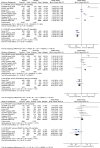Characteristics and long-term prognosis of patients with reduced, mid-range, and preserved ejection fraction: A systemic review and meta-analysis
- PMID: 35043472
- PMCID: PMC8799045
- DOI: 10.1002/clc.23754
Characteristics and long-term prognosis of patients with reduced, mid-range, and preserved ejection fraction: A systemic review and meta-analysis
Abstract
Aims: Patients with heart failure (HF) have a poor prognosis and are categorized by ejection fraction. We performed a meta-analysis to compare baseline characteristics and long-term outcomes of patients with heart failure with reduced (HFrEF), mid-range (HFmrEF), and preserved ejection fraction (HFpEF).
Methods and results: A total of 27 prospective studies were included. Patients with HFpEF were older and had a higher proportion of females, hypertension, diabetes, and insufficient neuroendocrine antagonist treatments, while patients with HFrEF and HFmrEF had a higher prevalence of coronary heart disease and chronic kidney disease. After more than 1-year of follow-up, all-cause mortality was significantly lower in patients with HFmrEF 9388/25 042 (37.49%) than those with HFrEF 39 333/90 023 (43.69%) and HFpEF 24 828/52 492 (47.30%) (p < .001). Cardiovascular mortality was lowest in patients with HFpEF 1130/9904 (11.41%), highest in patients with HFrEF 3419/16 277 (21.07%) mainly coming from HF death and sudden cardiac death, and middle in patients with HFmrEF 699/5171 (13.52%) and the non-cardiovascular mortality was on the contrary. Subgroup analysis showed that in high-risk patients with atrial fibrillation, the all-cause mortality of HFpEF was significantly higher than both HFrEF and HFmrEF (p < .001). HF hospitalization was lowest in patients with HFmrEF 1822/5285 (34.47%), highest in patients with HFrEF 12 607/28 590 (44.10%) and middle in patients with HFpEF 8686/22 763 (38.16%) and the composite of all-cause mortality and HF hospitalization was also observed similar results.
Conclusions: In summary, patients with HFmrEF had the lowest incidence of all-cause mortality and HF hospitalization, while the highest all-cause mortality and HF hospitalization rates were HFpEF and HFrEF patients, respectively.
Keywords: heart failure with mid-range ejection fraction; heart failure with preserved ejection fraction; heart failure with reduced ejection fraction; mortality.
© 2021 The Authors. Clinical Cardiology published by Wiley Periodicals, LLC.
Figures



References
-
- James SL, Abate D, Abate KH, et al. Global, regional, and national incidence, prevalence, and years lived with disability for 354 Diseases and Injuries for 195 countries and territories, 1990‐2017: a systematic analysis for the Global Burden of Disease Study 2017. The Lancet. 2018;392:1789‐1858. - PMC - PubMed
-
- Solomon SD, Anavekar N, Skali H, et al. Influence of ejection fraction on cardiovascular outcomes in a broad spectrum of heart failure patients. Circulation. 2005;112:3738‐3744. - PubMed
-
- Pocock SJ, Ariti CA, McMurray JJ, et al. Predicting survival in heart failure: a risk score based on 39 372 patients from 30 studies. Eur Heart J. 2013;34:1404‐1413. - PubMed
Publication types
MeSH terms
LinkOut - more resources
Full Text Sources
Medical
Research Materials
Miscellaneous

